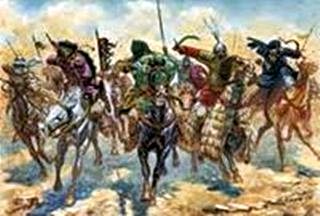
Battle of Kopidnadon |
year: 788September 788 |
| Defeat of a Byzantine thematic army by Arabs in Capadocia | ★ ★ ★ ★ ★ |
|
enemy: Arabs (Abbasids)
|
location: Somewhere in Cappadocia, west of Taurus mountains, perhaps near Pedadnos, modern Pozanti
|
accuracy:
●●●●●
|
|
battle type: Pitched Battle |
war: |
modern country:
Turkey |
| ▼ The Byzantines(emperor: Irene of Athens) | ▼ The Enemies | |
| Commander: | Unknown | Unknown |
| Forces: | ||
| Losses: |
| Background story: |
| After the great Abbasid invasion of Asia Minor in 782 and the defeat of the Byzantines in Bithynia, Empress Irene of Athens was forced to sign a peace treaty under which Byzantium was obliged to pay the caliphate 90,000 gold coins every April and 70,000 every June. In return, the Arabs pledged not to carry out their usual (since the beginning of 8th century) annual raids on the Byzantine territories of Asia Minor. The peace in these humiliating terms lasted 3 years. In 785, the Empress decided to stop paying the tribute, and the war resumed. The Arabs invaded the Armenian Thema, but in early 786 the Byzantines retaliated by occupying and leveling once again the city-fortress of Hadath (the ancient Greek city of Adata) in Cilicia. This city has always been the base for the annual Arab invasions but it was destroyed in 779 by the Byzantines; the Arabs had rebuilt and fortified it since then. The new caliph Harun al-Rashid (“Aaron the Righteous”), although he had taken an active part in the invasion of 782, when he became caliph in 786, did not show much interest in continuing operations in Asia Minor against Byzantium. Just a few, small-scale raids were organized, possibly at the initiative of local Muslim chieftains in the border areas. That changed in the summer of 788, when a large Arab expeditionary force crossed the Cilician Gate and entered Byzantine territory. |
The Battle: |
 The two armies met in Kopidnadon. The location has not been identified exactly, but it is probably the city of Podyandos or Podandos in Cappadocia, near the western exit of the Cilician Gates. The Byzantines were defeated with heavy losses. One of the dead of the battle was the tourmarches (head of turma=division) Diogenes. For some reason the Byzantine historian Theophanes the Confessor considers this loss very serious. |
Noteworthy: |
| It seems that the most remarkable thing for the Byzantines in this battle was the death of the brave Diogenes. This fact, in combination with the name’s similarity, have led to the hypothesis that perhaps Diogenes was the archetype of the hero in the epic of Digenes Akritas. |
Aftermath: |
| Despite the defeat and the losses, the consequences of this battle must not have been particularly serious as there is no mention of an escalation of the Arab attacks in the following years or a deterioration of the position of the Byzantines in Asia Minor. In the end, perhaps the only reason this battle has remained in history was the death of Diogenes and the speculation of identification with Digenes Akritas. |
|
|
